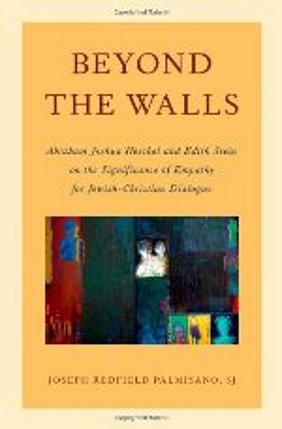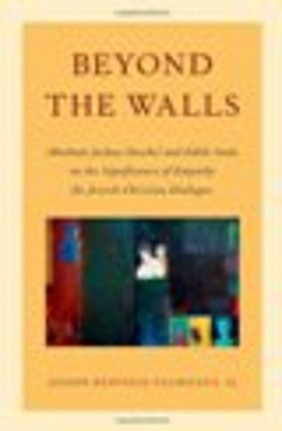The significance of empathy for Jewish-Christian dialogue selected from the writings of Rabbi Abraham Joshua Heschel (1907-72) and Edith Stein (1891-1942) is presented by Joseph Redfield Palmisano, SJ, who develops a phenomenological category of empathy defined as a way of “remembering” oneself with the religious other. Informed by voluminous primary and secondary sources, Palmisano offers a balanced synopsis of the thought and experience of Heschel and Stein on what constitutes matters of divine pathos and passion in the understanding of self and other within the matrix of Judaism; the religion and the peoplehood; and Christianity, belief, and theology. Between an introductory overview and a chapter of summary and conclusions, multiple chapters assess the fundamentals, principal components, rituals, and behavior patterns of distinct engagement with the other; examine what is acceptable and unacceptable behavior and belief paradigms; and broaden the discussion to show how interwoven are the ethical, moral, and religious strands of Judaism and Christianity in the post-Shoah era. His depth and phenomenological approach perforate text and footnotes and this may prove burdensome to the non-initiate in philosophic argumentation. Palmisano’s persistent intertextual methodology unveils the synchronic structure and position of the traditional sources and the defining role that they play in describing acceptable interfaith dialogue. More than not, the rabbinic gems unearthed by the spade of Palmisano’s consistent questions, answers, and reflections are a worthwhile guide to Jewish- Christian reappraisal and respect. The end is the beginning of an erstwhile venture into the will and way of scriptural faith to foster interreligious understanding, offering both a model of the ideal Jewish-Christian relationship in Heschel and Stein and criteria by which to evaluate current initiatives and controversies concerning interreligious dialogue.
Palmisano’s chapters on Heschel focus on the interdependence of revelation and reason, the divine and human encounter, and celebration of pathos theology. Admiringly and respectfully, Palmisano shows the reader how Heschel’s worldview drew from the wellsprings of prophetic scripture, and Jewish law and lore, and how this shaped his approach to God both Jewishly and universally. For Heschel, Judaic beliefs, rituals, symbols, and myths were directed to an ultimate authority--the creator of the world, revealer of Torah, and redeemer of Israel. Nonetheless, Heschel opined that this chosen-choosing God of the Shema and the Decalogue, who is spoken of ubiquitously in Israelite religion and in rabbinic Judaism, is beyond all creed, dogma, and standardized religion. Heschel referenced God as “being in and beyond all beings,” not defined in metaphysical abstraction or ecclesiastical argumentation but experienced in human interrelationship. Heschel’s experiential theology is rooted in humanity’s free will, which is central in Torah Covenant Theology, e.g., na`aseh ve-nishma (willingly “we shall do,” which explains why “we should hear /understand”). Prophetically speaking, this partnership embraces all nations and peoples who apprehend (recognize) but do not comprehend (understand) his glorious name. In chapter 1, Palmisano engages David Tracy’s “prophetico-mystical” approach with Heschel’s The Prophets (1962) and his speech to the Quakers, Versuch einer Deutung/A Search for a Meaning (1938), to construct a sensitive “prophetic” interreligious witness toward an ethical remembering of oneself with the other. Other chapters move deeply into the works of Heschel on metaphysical issues and phenomenology of subjectivity. On the latter, for example, is Heschel’s sympathetic prophetic response that embraces God as the Subject and the prophetic witness is seen as transubjective which in turn raises issues of the personhood of the messenger. This means that prophetic extension of the divine (vasum Dei) can nullify the selfhood; may this not be seen as a precarious state of extreme empathy?
In Palmisano’s view, Heschel’s “trans-subjectivity” speaks to the substance of Stein’s “con-primordially” introduced in her PhD dissertation, On the Problem of Empathy (1917). Quoting Jodi Halpern, Palmisano states, “Empathy is a process in which one person imagines the particular perspective of another person. This imaginative inquiry presupposes a sense of the other as a distinct individual” (p. 57). Palmisano opines that the writings of Heschel and Stein on empathy underscore a dialogical context where “empathy may mean a prolonged attentiveness and mindfulness that contributes to genuine interreligious partnership and cooperation” (p. 7). He shows a deep interest in the background and foreground of Stein’s “con-primordially,” highlighting the different ways in which the self-other has been received and interpreted in modern and premodern times. But it is the Christlike self of Stein that separates from Heschel’s Torah mandate that conveys a sympathetic not empathetic union as proposed by the author. In other words, honor and respect do not conflate the differences between their religious belief. In this regard, a discussion of Stein, Catholic and/or Jew, is necessary.
The nexus of Palmisano’s analytical study of Stein’s theory and practice of empathy is her response-cum-Christ to the horrific tragedy of the Shoah. Palmisano explores empathy in the life of Stein in the midst of the Shoah by her accepting the cross in her vocation and life as Sister Teresa Benedicta a Cruce (of the Cross). He pointedly demonstrates how she was witness to the cross, through her own kenotic and phenomenological teachings in The Science of the Cross (Kreuzeswissenschaft [1950]), and her voluntarily going to Auschwitz, enact a connected solidarity with suffering of others that is consistent with her hermeneutics from empathy. Though Catholic, she did not deny her Jewish roots, suggesting a unique dialectic in Stein as a bedrock of Christian-Jewish interreligious relations. Hinted but not fully explicated is the paradox of a Catholic Jew returning to her people as the extreme unction of Christlike empathy in suffering.
Stein was born in 1891 to a wealthy Jewish family in Breslau (now a part of Poland and known as Wroclaw). She studied philosophy at the University of Gottingen and earned a doctorate in 1916. She became an atheist, but in 1922, inspired by a biography of St. Teresa of Avila, she was baptized as a Catholic, and eleven years later, she joined the Cologne convent as Sister Teresa Bernedicta of the Cross. In the same year, she started to write her autobiography entitled Life in a Jewish Family. In 1938, she wrote to the pope and urged him to condemn the Nazis for the attacks on the Jewish synagogues and Jewish business places in an event known as Kristallnacht, “Night of the Broken Glass.” Not long after, her order sent her to Echt, in the Netherlands, where it was thought she would be safer than in Germany. In the early morning of May 10, 1940, the Germans marched into Holland, and ushered in the period of occupation. Two years later, the Dutch Catholic Bishops protested the Nazi authorities’ transportation of Jews to concentration camps in Eastern Europe. In reprisal, the Germans ruled that Jewish converts to Catholicism were to be seized and sent to the camps. On August 2, 1942, Sister Teresa was arrested at the Carmelite convent at Echt, along with her sister Rosa. A week later, they were both dead, gassed at Auschwitz.
Catholic authorities say that Stein “died as a daughter of Israel, ‘for the glorification of the most holy name (of God)’ and at the same time as Sister Teresa Benedicta of the Cross.”[1] There is no doubt that she died as a Christian, but can a “baptized Jew” qualify as a Jew? Eugene J. Fisher, executive secretary of the Secretariat for Ecumenical and Interreligious Affairs (Catholic-Jewish Relations) of the National Conference of Catholic Bishops (NCCB), believes so, and he points out that “there does exist Orthodox halakhic opinion that one who is born Jewish does not cease to be a Jew, albeit an apostate Jew, simply by conversion to another faith, even Christianity.”[2] However, a careful reading of the halakha in the name of R. Avda bar Zavda (b.Sanh. 44a) says otherwise. For it is said, “Israel has sinned” (Josh 7:11), meaning that even though he has sinned he is still an Israelite. This applies in the case of all forced converts who at heart are still loyal to God and Torah acceptance; forced converts to Christianity during the days of the First Crusade (1096-1105) and during the period of persecution in Spain qualify. Their historic experience, sooner or later, permitted them, some secretly and some openly, to renounce the vows imposed on them by persecution and by the Inquisition. When they returned to Judaism, they are seen as Jews who have sinned, past experience and not present reality. The decision of Stein to leave Judaism cannot be considered as an act of forced abandonment from her ancestral faith. Her apostasy is one of essence and not accidental. Pope John Paul II confirmed it at the mass for her beatification in Cologne on May 1, 1987.
The six million, including thousands who are outside the pale of halakhic recognition, are revered as the exemplar of the meaning and glory of Kiddush HaShem. It is suggested by Fisher that Stein was “simply one more Jew to be murdered with bureaucratic efficiency”; her Catholic tradition was not able to save her.[3] Thus, may her sin of apostasy be considered as null and void in light of her victimization and martyrdom? Perhaps, but unfortunately this does not nullify her decision to abandon Judaism (by choosing Catholicism), an affront to the locus classicus of Kiddush HaShem: “You shall keep my commandments and do them, I am the Lord. You shall not profane my holy name; but I will be hallowed among their children of Israel; I am the Lord who hallows you” (Lev 22:31-32). Judaism’s regard for human life (pikuach nefesh) permits under circumstances of pain or death violations of most commandments. Under no circumstances, however, may the three cardinal sins be willingly entertained: idolatry (apostasy); unchastity (incest, adultery); and murder. The dispensation of sins brought about by acts of Jewish martyrdom embrace “normal” transgressions (Sabbath ordinances, dietary laws, rites of passage, etc.) and do not contain the serious offenses against man and God.
Some authorities permit forced apostasy in private, i.e., less than ten Jews (male and/or female) in order to save one’s life. But Stein’s choice of Christianity was not coerced nor did she celebrate her conversion privately. In a prayer, she confesses to her savior, “that it is his cross, which now be imposed on the Jewish people.”[4] Also, on the way to Auschwitz, she is reported to have said to her sister, a convert to Catholicism, “Let us go, we will go for our people” (italics added). The words of Stein bear testimony to her Christian advocacy: expiatory sacrificial offering, imitating his “Heilig Blut,” for the atonement of the Jewish people. By the most lenient stretch of Jewish compassion, Stein, an individual, is a martyred Jewish victim. Ironically the church’s beatification makes her a blessed symbol of the cross, thereby declaring that she was (and not is) a Jew. Unlike living “baptized” Jews, who are potential returnees to Judaism, Sister Teresa’s faith as a Christian and fate as a martyr are sealed by Auschwitz and the Vatican.
In sum, this work is a fresh contribution to Jewish-Christian dialogue with special emphasis on theoretical and experiential empathy couched in a theology of suffering and martyrdom.



